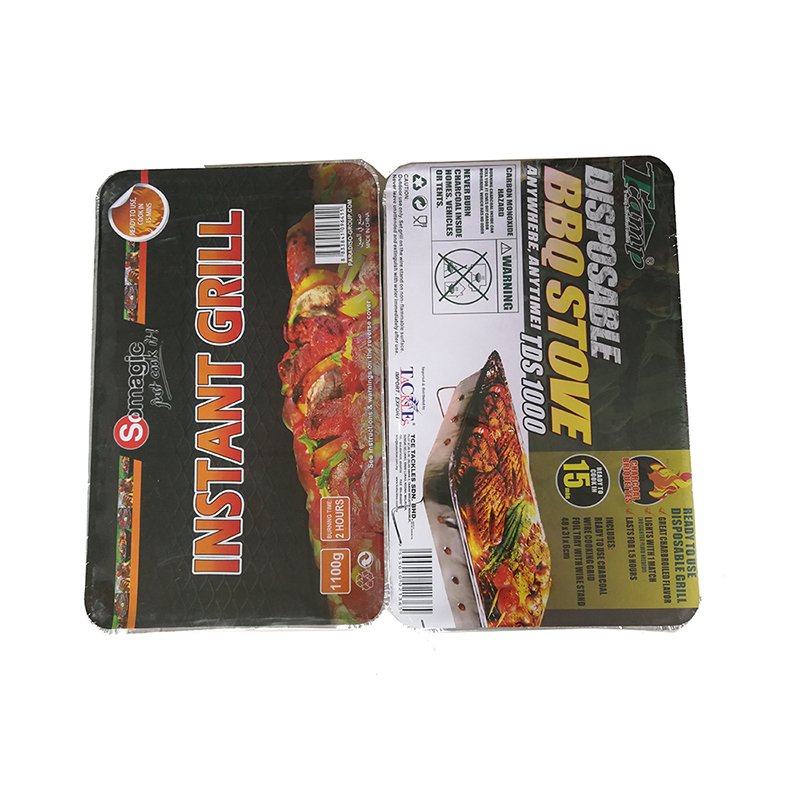stainless steel natural gas grill Fabrication and Wettability Study of WO 3 Coated Photocatalytic Membrane for Oil-Water Separation: A Comparative Study with ZnO Coated Membrane
by:Longzhao BBQ
2020-01-03

By simply spraying the nano-structured tungsten on the stainless steel mesh, the super-hydrophilic and underwater super-oleophobic surfaces were prepared, and their properties in the oil-water separation of the grid with oxide loading were compared.Gravity-driven oilThe water separation system was designed using these surfaces as a separation medium and it was noted that the tungsten 3 coated stainless steel mesh has a high separation efficiency (99%) with a pore diameter of up to m, however, in the process of oil, the zinc coating failed.Water separates when the aperture exceeds 50 μm.Because, the tungsten of the nano-structure is a well-known catalyst, under ultraviolet radiation, the simultaneous catalytic degradation of organic pollutants present in the separation water and oil-water separation process was tested using the surface of the tungsten coating, this degradation efficiency was found to be very significant.These results guarantee that in the case of little improvisation on the oil-water separation system, these surfaces can work in multiple functions at the same timeSeparation and removal of organic pollutants from separated water.Preparation of separation surfaces, morphological features, moisture, oil-water separation efficiency and lightThe efficiency of catalytic degradation was described.In an era of increasing industrial and energy consumption, the mixing of crude oil in seawater and industrial wastewater containing petroleum components/pollutants has become more and more common, which has adverse effects on precious water bodies.During the war, a large amount of oil, oil industry accidents and various gallons of water produced during the oil field caused environmental disasters.One of the main challenges faced by environmental researchers and managers in the oil industry is to find an effective oil-water separation method to comply with strict national and international environmental regulations.Many oil-water separation systems such as API (American Petroleum Society) oil-water separator, vertical gravity separator and ultrasonic separator have been established based on physical, chemical and biological methods, using electric field separation, coagulation and biological treatment.These oil-water separation methods require cumbersome and expensive instruments, but the oil-water separation efficiency produced by most processes is low, resulting in the generation of new contaminants as a by-product.In addition, various filmsOil-based water separation technology has been tried, but the main disadvantages of these separation methods are low efficiency, rapid membrane contamination and difficult treatment of contaminated membranes.Since oil-The water mixture is basically an interface phenomenon and an effective oilThe water separation method can be developed by utilizing the moisture properties of oil and water coated on materials coated on adsorption or separation media.By using materials with preferential wetting properties (Ie.Oil or water and non-Another can be wet), one of the mixture can be removed and the other retained.For example, it has a drain-Oil in nature can be oil and nonIt is proposed that water and materials with this wetting capacity can be used as effective media for adsorption and oil removal.Also sparse-The oil-friendly material is easily prepared by modifying the surface area of the material to surface tension less than water and surface tension greater than oil.However, the limitation of oil-water separation using materials such as adsorption is that after a certain amount of oil is absorbed, the surface is saturated and the adsorption efficiency is significantly reduced, so only a small amount of oil can be separated.Recycling of used materials is also required for further use or discard;Otherwise, these substances will become secondary pollutants.In addition, if the manufacturing of materials is expensive and needs to be replaced after each use, this method will not be cost effective.Another method of oil-water separation is based on the separation membrane, where-The parent-oil material is coated on porous materials such as fabrics or grids, in which the oil phase penetrates into the membrane and the water phase is retained, and the inherent limitation of this separation technology is that, since the proportion of oil is less than the proportion of water after a period of time, the water phase tends to accumulate in the lower part and form a column, which prevents the penetration of the oil phase.Another oil-water separation method that can be considered is the use of materials with opposite wetting properties as discussed earlier.This method is gravity-driven oil.Water separation in which the separation medium is a porous surface such as a stainless steel mesh coated with a hydrophilic coatingOil dredging materials, (water and non-The oil can be wet ).With these types of composite surfaces, water is expected to penetrate into the grid while maintaining oil, and since the material can be moistened by water, water naturally penetrates through the mesh without any external force.In addition, this type of material can respond to external triggers/parameters such as electric field, temperature, humidity, and pH of the environment, thus opening up a new path for oil controlSeparation of water.However, materials with this wetting capacity are very rare and difficult to synthesize, and even in theory this surface cannot be achieved by reducing the surface energy of the material.In the case of oil-water separation method, the use-Pro-oil and hydrophilic-The oil drain grid works by the capillary force of the wet liquid phase pointing down, notThe wet liquid phase points upwards, which makes the wet liquid phase penetrate into the grid and non-gridWet Ones are often retained.Due to the simple technology of these separation methods and the high efficiency of oil-water separation, many research teams are committed to developing ultra-thin oil surfacesSuper hydrophilic.Because some synthetic methods are cumbersome (and perhaps unreliable) and costly, researchers turn their attention to the use of super-omnipotent (which can be moistened by any type of liquid) the possibility of properties as an alternative material for petroleum applicationsSeparation of water.On 2009, Li Jiang's team, driven by the super-all-around wet behavior of fish scales, found a new type of gravity-driven oil material.Separation of water.He observed that fish scales are super-omnipotent in the air and become a very oil-resistant (ultra-oily surface under water ), when immersed in water and pointed out that this extreme underwater oil rejection is due to the unique surface structure of fish scales with dual-scale roughness (I.e.Micro, nano scale ).Trapped aquatic solid in surface roughness-The liquid composite interface is repelled against oil, and with this idea in mind, he prepared a gel-coated stainless steel mesh for oil-water separation, which has super-hydrophilic and super-oleophobic oil in water.After this discovery, a lot of research has been done to take advantage of the underwater oil resistance of petroleum materials.The separation and results of water are very successful, showing high performance and high separation efficiency.In this work, we have adopted a simple, fast, inexpensive and scalable method for the preparation of super-hydrophilic-By spraying commercially available nano-structure oxides and WO on a stainless steel mesh, the surface of the underwater super-oleophobic oil.The surface roughness and the surface morphology of the wet properties of the coating surface are studied, and these coating surfaces are used as separation media for gravity-driven oil-water separation.The coating mesh exhibits excellent water affinity and strong underwater oil rejection, so the oil-water separation system shows that the separation efficiency of all oil-water mixtures used for different pore sizes exceeds 99% dimensions and coating materials.The comparative advantages of nano-structures WO and ZnO 3 coated stainless steel nets with different pore sizes, based on the morphology of the manufactured surface and the surface wetting properties, the efficiency of them in the process of oil-water separation was studied.The study on the wetting properties of the two surfaces shows that the stainless steel mesh of the WO coating is in the oil-The water is separated because the former is able to handle the mesh with a larger aperture.The motivation to use the nano-structured WO as a coating material is that, in addition to providing sufficient surface roughness for the underwater oil-proof, they can be used as light catalysts, with simple UV/visible light or solar radiation, the presence of organic pollutants and microorganisms in the infiltrated water is disinfected by photo-catalysis.In addition, in this work, we demonstrate the ability of these coating surfaces to degrade organic pollutants present in the separation and infiltration of oil and water, this confirms the prospect of using these surfaces as a multi-functional surface for the simultaneous separation of light degradation of organic contaminants in oil and water and filtration solutions.It is reported that by doping the nano-structure WO with precious metals (such as palladium), it is expected to improve its photo-catalytic efficiency and be used for photo-catalytic disinfection and purification of water.The novelty of oil-water separation using WO coating grids is that these surfaces have the potential to work as multi-functional films where oil-water separation and light catalytic water purification can be performed simultaneously.This is because WO is a proven photo-catalyst that can efficiently degrade organic contaminants and microorganisms present in crude oil, such as hydrogen sulfide-reducing bacteria.In addition, the catalytic efficiency of WO can be further improved by doping WO with precious metals such as palladium.As far as we know, WO coating film is used to refuel at the same timeWater separation and photo-catalytic degradation of pollutants have not been reported.Another novelty of using WO coated stainless steel mesh is that it shows a high separation efficiency (99%), stainless steel mesh with a Aperture of up to m, while under the same intrusion pressure, the surface of the co2 coating with a pore diameter greater than 50 μm fails during oil separation.In addition to this, the method of preparing the coating surface by spraying is very simple, economical, fast, and can easily be extended to a larger surface.
Custom message








